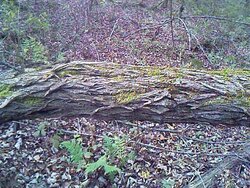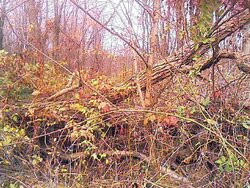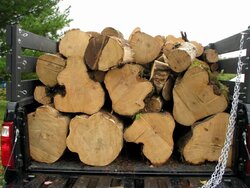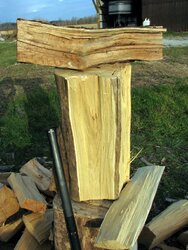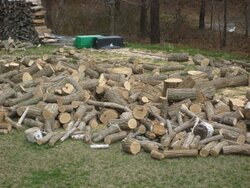I've mentioned a few times I cut a load of Locust but since I never even heard a tree called 'locust' before this year figure I'd ask. It was my brother in law that said there were several locust trees down, and after checking the btu chart I told him I'd be there in a flash. I am just taking his word I dont know what they really look like. So far I've cut mostly cherry, and I can honestly say these rounds feel nearly 50% heavier... to the point were a couple large rounds I couldnt get onto the truck bed myself (a couple ended up a tad long, ~24" that didnt help the weight issue). Most of these were standing dead or blow downs, very thick deeply furrowed bark that peeled off easy (and full of bugs) except for the net of poision ivy holding it all together.
I attached a couple crapy cell phone pics of similar trees around (not the ones I cut, but looked similar) for reference. And a pic of what the round looks like freshly split. It seems some of the pieces were more tan (I think maybe it turned more tan after drying) but the fresh split pieces had a yellow-green look to them. Many of the larger rounds my 8# maul just bounces, though I have been able to split some of them. Just a tad stringy too, much harder to separate than cherry. Oh and just for color reference thats a piece of cherry setting on top the round I freshly split.
I attached a couple crapy cell phone pics of similar trees around (not the ones I cut, but looked similar) for reference. And a pic of what the round looks like freshly split. It seems some of the pieces were more tan (I think maybe it turned more tan after drying) but the fresh split pieces had a yellow-green look to them. Many of the larger rounds my 8# maul just bounces, though I have been able to split some of them. Just a tad stringy too, much harder to separate than cherry. Oh and just for color reference thats a piece of cherry setting on top the round I freshly split.


